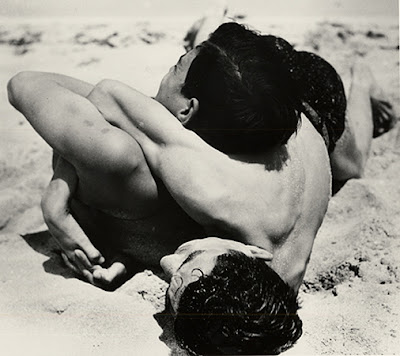Gay German photographer Herbert List (1903-1975) was the son of a prosperous family that ran a coffee brokerage business. List received a classical education in literature at the University of Heidelberg but apprenticed at his family’s coffee company, which afforded him travel to Brazil, Guatemala and Costa Rica. He began taking photographs during these business trips, and his legacy became black and white homoerotic photographs of young men.
In his earliest photographs List shot portraits of friends and composed still lifes with a Rolleiflex camera, using male models, draped fabric, and masks – along with double-exposures. He had a fascination with Surrealism and Classicism. List explained that his photos were "composed visions where my arrangements try to capture the magical essence inhabiting and animating the world of appearances.”
In 1936 List left Germany to take up photography as a profession, finding work in Paris and London. He was hired by magazines to shoot fashion photography, but he soon returned to still life imagery, producing photographs in a style he called "fotografia metafisica", which pictured dream states and fantastic scenes, using mirrors and double-exposure techniques.
During the late 1930s he traveled in Greece, where he took photographs of ancient temples, ruins, sculptures, and landscapes that were published in books and magazines. However, in 1941, during World War II, he was forced to return to Germany, but because one of his grandparents was Jewish, he was not allowed to publish or work professionally. In 1944 he was drafted into the German military, despite being homosexual and of partly Jewish ancestry. During the war he served in Norway as a map designer. A trip to Paris allowed him to take portraits of Picasso, Jean Cocteau, Christian Berard, Georges Braque, Jean Arp, Joan Miró and other international celebrities.
While working as art editor of Heute (Today) magazine he joined Magnum, a cooperative of photographers founded by Henri Cartier-Bresson, among others. For whatever reason, List contributed only sparingly from 1951 until the mid 1960s.
For the next decade he concentrated his work in Italy, where he began using a 35 mm film camera and telephoto lenses. In 1960 he shot portraits of Marino Marini, Paul Bowles, W. H. Auden and Marlene Dietrich (shown). Soon thereafter he gave up photography to concentrate on drawings, recently displayed at Berlin’s gay museum (Schwules Museum, Mehringdamm 61). Although List died in Munich in the spring of 1975, his style lives on in the work of Herb Ritts and Bruce Weber, particularly.
Trivia: In 1988, Stephen Spender published The Temple, a roman à clef of his pre-war years in Germany; the novel includes a character named Joachim, who is based on Herbert List.














